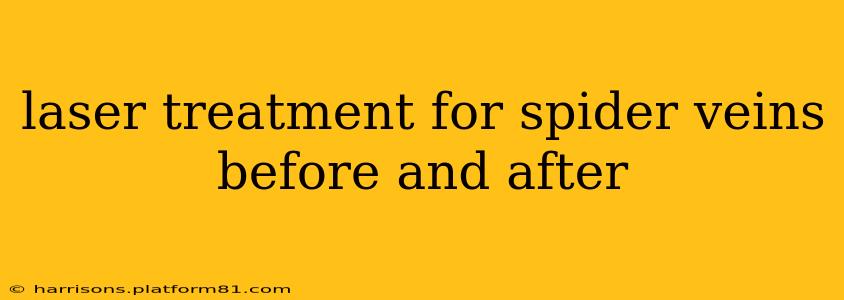Spider veins, those tiny, web-like red or blue vessels near the skin's surface, can be a cosmetic concern for many. While harmless, they can detract from the overall appearance of legs and face. Laser treatment has emerged as a popular and effective method for eliminating spider veins, offering significant improvements in appearance. This article explores the process, what to expect before and after treatment, and answers common questions surrounding laser spider vein removal.
What Happens Before Laser Spider Vein Treatment?
Before undergoing laser treatment, a consultation with a dermatologist or qualified healthcare professional is crucial. This appointment serves several vital purposes:
- Assessment of Your Veins: The doctor will examine your spider veins to determine their suitability for laser treatment. Factors considered include the size, location, depth, and density of the veins.
- Medical History Review: A comprehensive medical history review is necessary to identify any potential contraindications or risks associated with the procedure. This includes medications you are currently taking, allergies, and pre-existing medical conditions.
- Treatment Plan Creation: Based on the assessment, a personalized treatment plan will be developed, outlining the number of sessions required, the type of laser to be used, and potential costs.
- Preparation Instructions: You will receive detailed instructions on how to prepare for the procedure, which may include avoiding sun exposure, certain medications, or specific skincare products in the days leading up to treatment.
What are the risks and side effects?
While generally safe and effective, laser treatment for spider veins carries some potential risks and side effects. These can include:
- Pain or Discomfort: Most patients report minimal discomfort during the treatment, often described as a slight stinging or burning sensation. A numbing cream may be used to minimize any discomfort.
- Redness and Swelling: Temporary redness and swelling are common side effects that typically resolve within a few days.
- Bruising: Minor bruising is possible at the treatment site.
- Hyperpigmentation or Hypopigmentation: In rare cases, changes in skin pigmentation may occur, either darkening (hyperpigmentation) or lightening (hypopigmentation) of the skin. These changes are usually temporary.
- Scarring: Scarring is uncommon but a potential risk. The likelihood of scarring is reduced with proper technique and aftercare.
What to Expect During Laser Spider Vein Treatment?
The procedure itself is relatively quick and minimally invasive. A handheld laser device is used to target the affected veins. The laser energy heats the vein walls, causing them to collapse and be absorbed by the body. The entire process takes only a few minutes to several hours depending on the extent of the treatment area.
How long does the treatment take?
The treatment time depends on the size and number of spider veins being treated. It can range from a few minutes to an hour or more for larger areas.
Laser Spider Vein Treatment: Before and After Photos
Before and after photos are a valuable tool to showcase the effectiveness of laser treatment for spider veins. They visually demonstrate the dramatic improvement in the appearance of legs and face after the procedure. (Note: Due to the limitations of this format, I cannot display images here. However, searching online for "laser spider vein treatment before and after" will yield numerous results.) Always look for reputable sources and medical practices when reviewing these images.
What Happens After Laser Spider Vein Treatment?
Post-treatment care is crucial for optimal results and to minimize the risk of complications. Your doctor will provide specific instructions, but general recommendations include:
- Avoiding Sun Exposure: Protect the treated area from direct sunlight using sunscreen with a high SPF.
- Compression Therapy: Wearing compression stockings may help reduce swelling and bruising.
- Maintaining Hygiene: Keep the treated area clean and dry.
- Following Up: Schedule follow-up appointments as recommended by your doctor.
How many treatments are needed?
The number of treatments required varies depending on individual factors such as the extent of the spider veins and response to treatment. Multiple sessions are often necessary for optimal results.
How long does it take to see results?
Results are typically gradual, with noticeable improvement visible within weeks after the first treatment. The full effects may not be apparent for several months.
How long do the results last?
The results of laser spider vein treatment are usually long-lasting, but some individuals may experience recurrence of spider veins over time. Lifestyle factors such as sun exposure and weight fluctuations can influence the longevity of results.
By understanding the process, potential risks, and aftercare involved, you can make an informed decision about whether laser treatment for spider veins is the right choice for you. Always consult a qualified dermatologist or healthcare professional for personalized advice and treatment.
